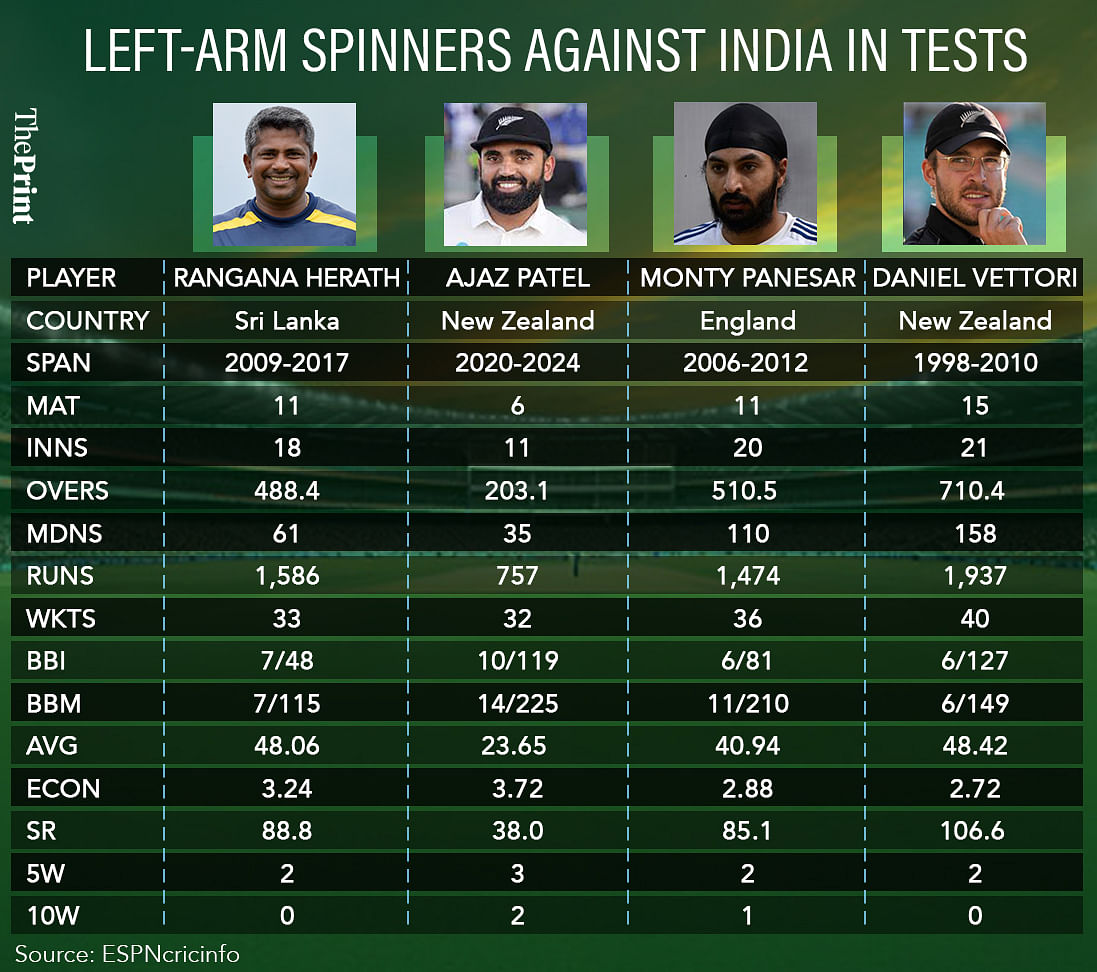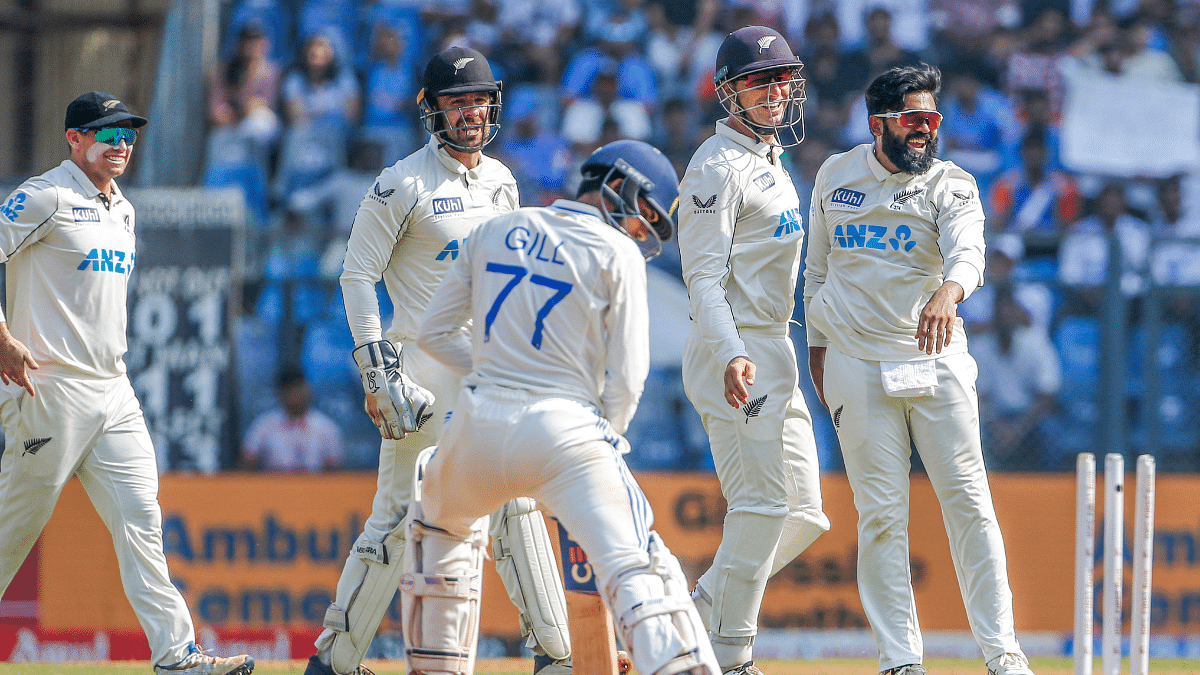New Delhi: When India suffered its first-ever clean sweep defeat in a three-match Test series on home ground, the question on everybody’s lips was: what went wrong? Some blamed the pitches for the humiliating 3-0 loss to New Zealand. Others pinned it on poor technique. But nearly everybody agreed on one thing: Indian batters completely failed to handle left-arm spin.
If there was any doubt about India’s capitulation to slow left-arm spinners, it was laid to rest when New Zealand spinner Ajaz Patel bowled India’s Washington Sundar through the gate in the final Test in Mumbai on 3 November while he was trying to go for a big shot.
But it wasn’t the first time Indian batters were spooked by left-arm spin: in fact, left-arm spinners have haunted some of the best Indian batters across generations.
From the legendary Sunil Gavaskar to the fans-declared God of Sachin Tendulkar and the best batter of the current generation Virat Kohli, one challenge unites these cricketing giants: their inability to counter left-arm spin on spin-friendly surfaces.
Gavaskar, who was present at Wankhede as a commentator, was apparently a “bunny” of England’s left-arm spinner Derek Underwood. In his first series at home in 1972-73, Underwood dismissed Gavaskar four times in 10 innings and limited him to just two half-centuries in five Tests.
Over 20 Test matches, Underwood dismissed Gavaskar 12 times – the most by any bowler at the international level. The trauma of Underwood might have been one reason why Gavaskar didn’t dissect the technique of Indian batters against New Zealand left-arm spinners.

India lost 11 wickets to Patel’s left-arm spin in the third Test of the series while Patel and Mitchell Santner took 15 wickets in the second Test to punish a hopeless India.
Santner has picked 67 wickets from 29 games in his Test career so far while Patel has scalped 85 wickets from 21 Test matches.
If the wickets taken by part-time off-spinner Glenn Phillips are included, India lost a total of 34 out of 40 wickets in the last two Tests of the series to spin – a telling example of its complete surrender to a spin bowling combination.
Numbers don’t lie
The Tom Latham-led Black Caps went on to become the first touring team to hand India a whitewash at home in a longer series. Never before in the history of Indian cricket were they drubbed so embarrassingly in a three-match Test series.
While many factors led to India’s humiliating loss to the Kiwis who were more disciplined and spirited, India’s inability to counter left-arm spin on surfaces offering ample natural variation was one of the most critical reasons.
It is hardly surprising then that the old guard such as Sachin Tendulkar, Yuvraj Singh and Anil Kumble have called for introspection and soul-searching. The crux of the problem lies in the range of dismissal options a left-arm spinner has when bowling around the wicket to a right-hander.
Experts say left-arm spinners are particularly tricky for right-handed batters because of the natural variation—some deliveries turn sharply across the face of the bat while others come on with the angle.
The traditional belief is that even bowlers don’t know what the ball will do after it leaves their hands.
Spinners aim to generate turn off the surface in the direction they want but they can’t control which ball will turn and which will go straight on with the angle.
Some exceptions exist where bowlers use their craft to produce variation from the hand such as Sri Lanka’s Rangana Herath, who invented a carrom ball that turned into a right-handed batter.
Interestingly Herath was roped in as the spin bowling coach for New Zealand’s sub-continent Tests.
Add the element of variable bounce and left-arm spinners become a deadly mix for right-handers – a challenge that’s been on display since the 2021 home series against England at home.
In that series, after Joe Root punished India on a flat Chepauk pitch in the first Test, India produced turners which led to it losing a total of 37 wickets to spin. Of those, 18 were scalped by the lone left-arm spinner, Jack Leach. He kept India’s top four right-handers – Rohit Sharma, Shubman Gill, Kohli, and Cheteshwar Pujara – on their toes throughout.
India already had a long list of disastrous performances against spin bowling such as Nathan Lyon’s 12-wicket haul at Adelaide in 2014, Herath’s seven-wicket haul that denied India a target of 176 runs in Galle in 2015, and off-spinner Moeen Ali’s nine-wicket haul that led to an embarrassing defeat at Southampton in 2018.
And the story has only become gloomier since 2021 when India faced Root’s England at home.
Pujara, regarded as one of India’s finest players of spin among the top order, fell to Leach on four occasions in six innings he played out of seven times India played in the series.
With his brisk pace and flat trajectory, Leach pinned Pujara to the crease, not letting him come out and smother the spin in his typical manner. Leach’s complete dominance over Pujara was clear from the fact that no spinner before Leach had dismissed Pujara four times in a series in his more than decade-long Test career.
Pujara’s struggles against Leach are clear from the statistics: between April 2017 and January 2021, he was dismissed by a left-arm spinner only once in 502 balls but Leach managed to get him out four times in only 89 balls.
Since the onset of the COVID-19 pandemic that disrupted Indian cricket and until the end of the last series against New Zealand, three of the five top wicket-takers in India have been left-arm orthodox spinners.
Aijaz Patel, Tom Hartley and Leach make that venerable list while Santner also features among the top wicket takers even though he played just one game. He had a big impact on the Pune Test where he picked 13 wickets and decimated India.
Also Read: Sunil Gavaskar on disadvantages of cricketers taking frequent breaks. ‘Very difficult to win after’
Not a recent trend only
Left-arm spin has always been a thorn in India’s side. One of the examples was when Maharashtra Cricket Association Stadium was hosting the first Test match against Australia in Pune in 2017.
India under Virat Kohli were a roaring Test side at home. The top layer of the surface was dry and dusty and the pitch was rated poor by the match referee Chris Broad.
Australian skipper Steve Smith won the vital toss and though Indian spinners tried their best to turn the ball, the visitors piled on 260 runs. But India were not aware of what was in store for them.
Left-arm spinner Steve O’Keefe made matters much worse in a span of just five balls. Just as India looked somewhat settled at 94 for the loss of three wickets, O’Keefe dismissed K.L. Rahul, Ajinkya Rahane and Wriddhiman Saha in the same over to dismiss India for a paltry 105 runs in the first innings.
If the lead of 155 runs was not enough on that surface, Steve Smith played one of the most remarkable Test innings and asked India to chase an insurmountable target of 441 runs.
Out came the nemesis in O’Keefe who scalped the valuable wickets of then in-form Murali Vijay and Cheteshwar Pujara with deliveries that skidded off the surface while Kohli suffered due to an error in judgement. He bagged seven wickets in the second innings and handed Virat Kohli’s India their first defeat at home.
O’Keefe went on to play the other three games of the series as well but wasn’t as successful because the pitches improved and Indian batters found it easier to handle him.
Though a right arm spinner, Nathan Lyon continued to torment them by picking 14 wickets over the next three Test matches.
In a similar vein, Australia last year understood that the Rohit Sharma and Rahul Dravid-led think tank was adamant about playing on what are known as rank turners.
Recognising his potential, Australia added left-arm spinner Matthew Kuhnemann to the squad for the variety he offered as a left-arm spinner. Australia had the duo of Nathan Lyon and Todd Murphy,,a right-arm off spinner, but Kuhnemann offered them an option to turn the ball away.
Kuhnemann repaid the trust in the third Test in Indore by picking up three of the top six batters – including Rohit, Gill and Shreyas Iyer, who was considered a good player of spin in his maiden five wicket haul. While Rohit was beaten in the flight, Gill was guilty of pushing at the ball with hard hands.
Though it would be unfair to categorise former England spinner Monty Panesar as a one-Test wonder, he had one match-winning performance that jolted M.S. Dhoni’s India, leading to a loss in the series at home in 2012.
India posted a respectable score of 327 runs in the first innings of the second Test of the four-match series in 2012-13 but not before Panesar confused the Indian star-studded batting lineup with his accuracy and natural variation.
Panesar ripped one across the face of Tendulkar’s bat with a delivery that pitched on leg stump, hitting the timber and silencing the Wankhede crowd into mourning and leaving India with their task cut out.
Pujara brought his best game forward, producing a masterful hundred to help India reach 327 runs in the first innings. But his efforts were overshadowed by the genius of Kevin Pietersen, who exorcised the ghost of left-arm spinners from his Test career. He smashed Indian spinners to all corners of the ground, scoring 186 runs on a surface that experts said would see England rolling over in just two sessions.
Reeling behind by 86 runs, India found themselves in trouble as Panesar got Sehwag and Tendulkar with two contrasting deliveries typical of left-arm spinners.
Sehwag was drawn on to front foot by a delivery that turned away from him and Tendulkar was trapped in front while looking for non-existent spin on a ball that got him out.
Panesar went on to pick 11 wickets in the game, putting England in a dominant position it didn’t look back from in that match and the series. India’s performance put Dhoni’s Test captaincy and seniors’ career on the brink.
Three years later in 2015 in Kohli’s first assignment as full-time Test skipper, India were chasing 176 runs in the last innings of the first Test against Sri Lanka at Galle. However, they had Rangana Herath to contend with.
Herath spun past the outside edges of K.L. Rahul and Rohit’s bats to leave India in tatters early in the innings. He finished the job by dismissing Rahane, Harbhajan Singh and Saha in quick succession.
India’s failure to beat left-arm spinners saw them bundled for a mere 112 runs, losing what was shaping up to be an easy win for the men in blue.

The concept of making an average spin bowler look extraordinary was on display during the Mumbai Test match against Australia in 2004.
India were 182 for four wickets with Dravid and Mohammed Kaif finding their feet on a dustbowl. However, they slipped in no time against the brisk left-arm spin of Michael Clarke, who bowled around off the stump line and nearly spun India out of the game.
It took the heroic performance by Harbhajan and Murali Karthik to dismiss the mighty Australians for 93 and for India to win a game that appeared out of their grasp.
Another traditional left-arm spinner, New Zealand’s Daniel Vettori – known as a pioneer of varying pace to outclass batters – enjoyed some success against India in the longest format.
This included a six-wicket haul against India in the second of a three-match Test series in 1999. Although he didn’t deliver an extraordinary performance against India in Tests, he picked up 40 wickets from 15 Test matches against the men in blue between 1997 and 2014.
Current malaise: error in picking length, premeditation
Although there is a long history of Indian batters falling short of left-arm spinners on very helpful surfaces, the issues against New Zealand were unprecedented.
While the performance against O’Keefe and Clarke could be called aberrations because the batters picked themselves up neatly after falling quickly to spinners, the series against New Zealand highlighted both technical and mental issues.
Three of the most frustrating dismissals of Indian batters in the New Zealand series were Sarfaraz Khan’s sweep in the final innings, Yashasvi Jaiswal’s reverse sweep in the first innings of the Test and Kohli’s slog sweep in the first innings of the Pune Test.
Sarfaraz and Jaiswal’s dismissals were most probably due to their premeditated approach instead of watching the length and line of the ball and adapting their shots to the delivery.
Had they reacted to the delivery, the shots would have been different: Jaiswal could have just played a conventional sweep because of the line of delivery while Sarfaraz could have whipped it through midwicket with his wrist.
Kohli’s dismissal though appeared to be a mixture of both. First, he had come out with an intent to not be defensive against spinners, especially since his attacking approach fetched him runs against spinners in Bengaluru.
However, his premeditated attempt of sweeping everything around the leg stump line proved fatal as he missed a juicy full toss which could have been thrashed between mid-wicket and square leg had he employed his deadly wrists on it.
The following day, Santner was in top form, having identified the perfect line and length for that surface that offered him grip and bounce at a slower pace.
Rohit struggled to handle Santner’s variations and tried to play him from outside the crease. Once again, he misjudged the length as he could not reach the pitch of the ball and the inside edge onto his pads was gleefully accepted by the forward short leg fielder.
Former Indian batter Sanjay Manjrekar often says that if a batter cannot reach the pitch of the ball even with a fully stretched front foot, it is proof that the ball is short enough to be played from the back foot.
This is the cardinal sin that Kohli was guilty of committing at Wankhede in the second innings.
To be fair, it was not easy for any new batter to start on that surface with balls spinning from the middle of the surface. Also, he has had his fair share of failure playing off the back foot to be not strict about playing spinners from deep inside the crease.
Kohli has been caught in the crease on a number of occasions against balls he should have lunged forward for or by lunging forward to balls that he should have played on the backfoot.
No wonder his numbers against left-arm spinners have nosedived since the 2021 home season. In the second innings of the Pune Test, he made the error of going back to a delivery he should have played on the front foot and paid the price by getting trapped before the stumps against Santner.
Conversely, he made the mistake of lunging too far forward against Patel’s leg stump line delivery that turned viciously and bounced to take the shoulder of his bat to the slip.
Commentators dubbed the ball “unplayable” but a closer look at the replay revealed that Kohli’s overcommitment to the front foot denied him any option to deal with extravagant turn and bounce on that delivery. The ball could still have got him dismissed but it was not as unplayable as his forward lunge made it out to be.
Kohli’s ability to manoeuvre left-arm spin has waned dramatically as reflected in statistics. Until 2019, he maintained a phenomenal average of 110 runs per innings against left-arm spinners, scoring 775 runs off 1,414 balls across 52 innings.
However, since 2020, Kohli’s numbers have crashed to a mere 289 runs from 28 innings with his average down sharply to just 24.1 runs per innings.
Kohli’s decline against left-arm spin was evident in his desperate scramble for a run on the third-last ball of the first day of the Mumbai Test. It shows the mental blocks that Kohli and other Indian batters face when playing left-arm spinners.
Rohit, who looked like the best Indian batter against spinners during the England series at home in 2021, also struggled against Santner’s left-arm spin in Pune.
Earlier, in the series against England this year, he was beaten on the outside edge by England’s left-arm spinner Tom Hartley, who went on to scalp six more wickets in the second innings to jolt India in the first Test of the series.
His numbers too have plummeted since 2019, his peak year as a Test batter at home when he was averaging 89 against left-arm spinners. The numbers have been on a downward trend with the average against left-arm spinners hovering between 21 and 36 between 2021 to this year.
For Gill, a quick correction was made to fix a flaw in his technique where he kept bat beside the ball. Former Indian wicketkeeper batter Dinesh Karthik spotted the problem during on-air commentary.

With that technique, Karthik prophesied that Gill was susceptible to both LBW and potentially lobbing a catch off the inside edge of his bat to the close-in fielders.
Gill’s vulnerability was clear when he fell LBW to Santner in the first innings while playing a ball that did not turn and went on with the angle.
While his game against spin has improved since the series against England, some obvious chinks in his armor remain: his tendency to play defensive shots with hard hands and keep his pad in line with the ball of spinners which are a deadly combination.
India are heading to Australia where they have to counter a different set of challenges.
With the selection of off-spinner Todd Murphy as the lone spinner in the Australia A side to play India A, it seems the visiting team won’t have to deal with their perennial nemesis: left-arm spinners.
However, this doesn’t mean the Indian batters won’t face challenges. Pat Cummins and his bowling attack could pose just as big a threat to Indian batters on Australian surfaces as left-arm spinners on Indian pitches.
(Edited by Sugita Katyal)
Also Read: Takeaways from India’s World Cup 2023 campaign. Flying starts, spit-fire bowling & reimagined game






